Posted: August 31st, 2022 | Author: ucdcoc | Filed under: Disorientation Guide '22-'23 | Comments Off on Writing to People Inside
⟵ Back to Table of Contents
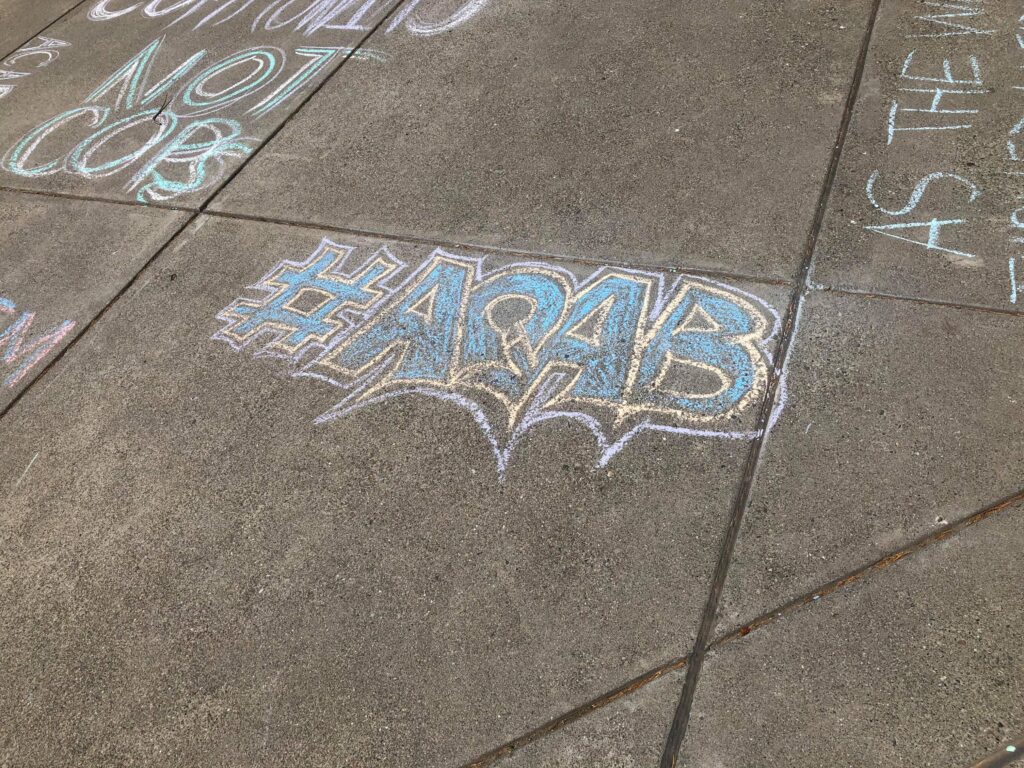
Isolation is central to carceral logic. Maintaining connections to the world beyond prison and building relationships there is vital to the support and well-being of those folks incapacitated inside of prisons, jails, and detention centers. Writing letters is a practical way to break down isolation, build relationships, nurture communities, and connect folks with potential resources and information. Receiving consistent mail can also signal to prison officials that someone has a support system, which can potentially help to deter the state from targeting them with violence and harassment.
Things to Consider
Writing to people inside is an easy action that can have a huge impact on the spirit and well-being of people inside. Here are a few things to consider if you want to become a penpal with someone who is incarcerated.
- Capacity. Be transparent about your capacity and be as consistent as possible with your correspondence. Don’t promise to write all the time if you can’t. Just communicate how much you can write and how frequently and try to stick to it.
- Be frank and sincere. Don’t promise things that you can’t deliver – books, commissary funds, gifts, etc.
- Surveillance. Keep in mind that every letter is potentially read by the guards, so don’t write anything that might incriminate yourself or others. Do not write about illegal activities. Don’t write about the person’s case. Remember that some incarcerated folks are pretrial, which means that letters they recieve can be entered as evidence.
- Political prisoners. If you are writing to someone who the state has targeted for political activity (i.e. “political prisoners”), don’t treat them as heroes or martyrs, as this can increase the risk that they will continue to be targeted by the state and prison authorities as “leaders.”
- Political materials. Be careful about sending political materials unless the incarcerated person has specifically asked for them or sanctioned it in some way directly. Sending anything subversive could lead to potential problems for the person.
Choosing your penpal
If you do not have a direct contact or relationship with an incarcerated person, there are many ways to select a potential penpal and begin correspondence. Here are just a few examples of places to start:
- California Coalition for Women Prisoners, which organizes a “Crossfire Correspondence” program and trains volunteers to respond to the many letters they receive each week
- Black and Pink, which maintains a list of queer and trans folks in prison who are looking for penpals.
- Survived and Punished, which maintains a list of incarcerated survivors of domestic and sexual violence.
- New York City Anarchist Black Cross, which regularly updates an illustrated guide to political prisoners
- Organize or plug into a prisoner letter writing campaign. There are collectives and groups across the country that organize resources for prisoner letter writing and maintain lists of incarcerated folks interested in correspondence. Check your local networks, or work with some friends to start your own. Big Door Brigade is a great resource to start with, as is Black and Pink.
You may not hear back, and that’s ok
It is not uncommon not to get a reply letter. Incarcerated folks often do not receive all the letters written to them, they may not have access to the necessary materials (which cost money) to regularly correspond, or for whatever reason they may be uninterested in writing letters. That doesn’t mean you should be deterred from the idea of writing to people inside for support and solidarity. Continue sending support and try reaching out to other folks.
What to Write
Don’t be intimidated by the uncertainty and awkwardness that may come from developing a pen pal relationship. Start with an introduction and context – say who you are and why you are writing to them. Tell stories about your life that you are willing to share. Write about what you are passionate about and interested in. Be as detailed as you can. Incarceration strips away the sensory experiences of the world – do your best to include that information. If you don’t know much about the person you’re writing to, ask them about their interests.
Please keep in mind the mixed literacy levels among incarcerated people and try to respond appropriately.
Be mindful not to speak down to or condescend to anyone. Be aware and take into account the asymmetrical power dynamics, both inside and outside the walls, and work towards their abolition, including in language and communication.
Some Writing Guidelines
Make sure to write the person’s full name and prisoner ID number on the envelope. It is best to use a street address for your return address, as some prisons don’t accept PO Boxes or “care of” addresses. Be sure to select an address that you are comfortable sharing with prison authorities. If you know of a group that maintains an address for this express purpose, even better.
No glitter. Depending on the prison or jail, no marker, crayon, or colored pencils either. It is best to write in non-gel blue or black ink, or through an email system if available. Once you have selected someone to correspond with, make sure to read the specific guidelines for their particular prison or jail in regard to sending and receiving mail or email.
You cannot include articles or anything else torn out of a newspaper or magazine. However, you can print that same article from the internet, photocopy it and write your letter on the other side, or copy and paste the content (if over email).
You cannot include polaroid pictures, but you can include regular photographs. Some prisons limit the number of photos that incarcerated folks can have at any given time, so check with your penpal before sending a stack of photos.
If mailing more than a letter, clearly write the contents on the envelope/package. Label it “CONTENTS” and include a full list.
Make sure you include your return address on the letter you write, as well as on the envelope. It’s common for prisoners to receive letters without the envelope. Number each page of your letter, such as 1 of 3, 2 of 3, etc. This ensures that if pages of your letter don’t make it to the incarcerated person, they will know.
Date your letters. Again, they may not receive the dated envelope. Having a date on the letter you send can help people track any mail delivery delays.
Banned materials
The following are banned by most prisons and jails, so just avoid using them:
- Thick, multi-layered greeting cards
- Colored paper of any kind
- Stickers, glue, confetti, glitter, ribbons/additional items on greeting cards
- Oversized envelopes (try to only mail standard sized envelopes, legal-size paper, preferably 8 ½ x 11 max)
- Drawings on envelopes (unfortunately, your art might be considered “graffiti”)
- Crayon and colored markers
- Tape on envelopes in general, clear scotch tape or otherwise
- Peel and press envelopes, and envelopes with metal brads that press down.
- Books. Generally, books must be sent directly from the publisher or major distributor (Amazon, Barnes and Noble, etc). Check with the person about what books they are interested in, ask if they have a wishlist, and then (if you have the means) purchase the book (or books) from the publisher or distributor and have it sent directly to the prisoner. Make sure to check the prison or jail guidelines on receiving published materials.
Further resources
This article was originally published by our friends at Abolish the UC in their 2020 Disorientation Guide.
Posted: August 31st, 2022 | Author: ucdcoc | Filed under: Disorientation Guide '22-'23 | Comments Off on Intro to Affinity Groups
⟵ Back to Table of Contents
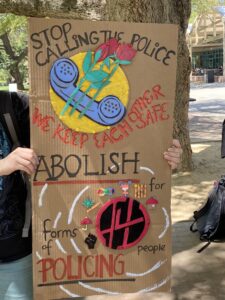
Affinity groups are self-sufficient support systems of about five to fifteen people who build trust, choose to struggle and work together, and share “affinity” in ideas, visions, and goals. Affinity groups are composed of people who have been brought together through movements or have existing ties such as friendship, living in the same area, or working together. The goal of an affinity group is action and might be better conceptualized as a crew of people who are down for similar things, whether it be political education, sabotage, “street art,” campaigns, publishing etc. “Abolish the UC” is an example of a type of larger affinity group, but they can also take the form of a group of friends who come together to feed unhoused community members or a prisoner support group. Sometimes, affinity groups remain together over a longer period of time, existing as political support and/or study groups, and only occasionally participating in actions. They provide a tactile and flexible mode of organizing that is able to change with rapidly shifting conditions.
A number of affinity groups may work together toward a common goal in a large action, or one affinity group might conceive of and carry out an action on its own. Affinity groups often form the basic decision-making bodies of mass actions. They are considered “autonomous,” independently entitled to develop any form of participation they choose. Groups of affinity groups working together are sometimes called “clusters.” A large action can have several large “clusters” all working together. In large actions, affinity groups usually send “spokespersons” to a “spokescouncil” meeting, to communicate and coordinate the different groups’ decisions and then bring the coordinated information or proposal back to their respective groups for their final discussion and approval.
Affinity groups also serve as a source of support for the members and reinforce a sense of solidarity. They provide a solution to the isolation or separation that can affect individuals acting alone. By including all participants in a circle of familiarity and acquaintance, the affinity group structure reduces the possibility of infiltration by outside agents or provocateurs. The key element is trust; if you’re planning on doing things that aren’t necessarily legal, you definitely need to make sure you can trust everyone in the group. An affinity group conspires together, figures out logistics, and makes shit happen. There is absolutely no room for bragging or talking about what happened outside those involved. NEVER FUCKING SNITCH. This keeps repression and risk to a minimum.
When bringing new people in, it’s crucial that they are in “affinity” with the goals and approaches the existing group chooses to take, and enter as equals. Because they are not “official” organizations, participants can choose to leave or dissolve the group when affinities weaken or are no longer necessary. Affinity groups are a powerful organizing tool that can exist alongside a diversity of approaches, strategies, and tactics.
Five Tips for Forming an Affinity Group
- Start where you are. Can you think of five people who might want to form an affinity group? Congratulations, you’re halfway there! Bring those five folks together for dinner to talk about reaching five more. Can you think of three, or just one? That’s okay! Do the same thing – have dinner and begin brainstorming. You never know where your conversations may lead.
- Take action early on. Once you have a group, get out of the house! Carpool to a rally, foreclosure blockade, or community garden “work day.” Or do something social – attend a workshop, go hiking, cook something, etc.
- Learn about small group decision-making. As your group continues to meet, you will inevitably encounter differences of opinion. Decide how you’ll resolve these differences, such as through the consensus model or other means. Try to include someone with small group facilitation experience or ask a few members to learn facilitation skills.
- Go beyond politics – bring your “whole self” to meetings. What are the roots of our political commitments? What values and personal experiences motivate us? Create space to share your stories. Create space for your non-political selves as well. What are your jobs, passions, interests, hobbies? Where are you from? What are your experiences? This can also help to suss out and address underlying power dynamics, particularly in groups of people from different class backgrounds, people who are racialized or gendered differently, or people who have differing legal statuses. For parents, bringing your whole self to a meeting may mean bringing your kids! Invite kids to eat with the group, and then set up a kid-friendly video in the next room. Find a babysitter and “pass the hat” to pay them. Or take turns watching the kids.
- Meet over a meal. There’s something magic about food (and drinks). Try to meet at someone’s home over a potluck, or rotate meal duty.
Resources For Affinity Groups
This article was originally published by our friends at Abolish the UC in their 2020 Disorientation Guide. The Five Tips and Resources sections were taken from Resilience Circles.
Posted: August 31st, 2022 | Author: ucdcoc | Filed under: Disorientation Guide '22-'23 | Comments Off on Reflections on Risk
⟵ Back to Table of Contents
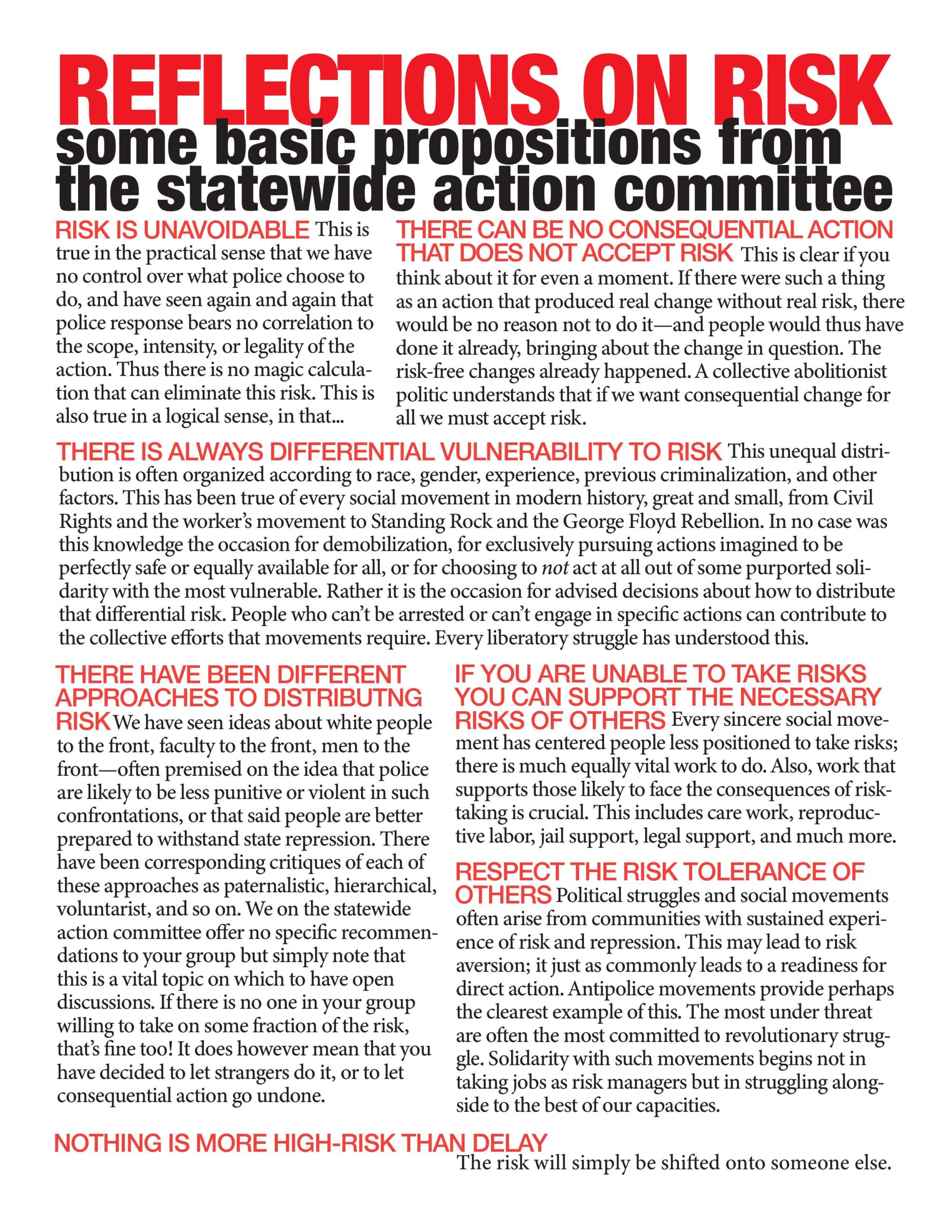
Posted: August 31st, 2022 | Author: ucdcoc | Filed under: Disorientation Guide '22-'23 | Comments Off on From a Free Latitude
⟵ Back to Table of Contents
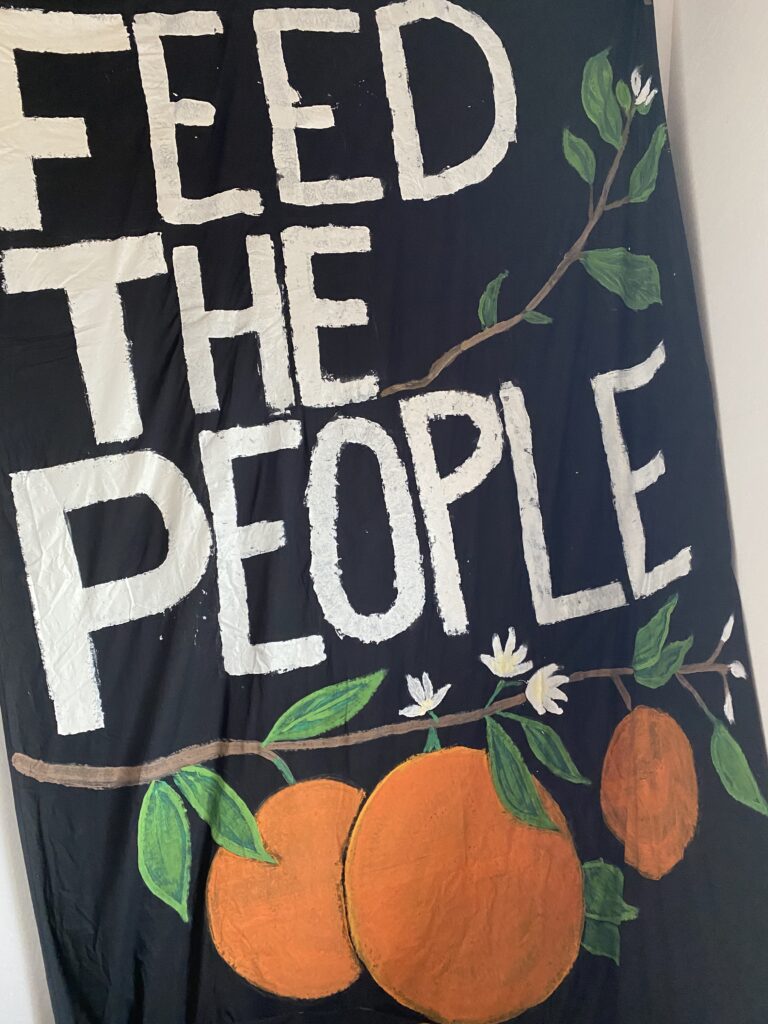
On May 18, 2022, UCD Cops Off Campus and other student and community members liberated Latitude Dining Commons, disabling the swipe station and making lunch free for everyone. What follows is our communiqué published from inside the liberated dining hall. You can also read our reportback from the action (originally published by our friends at Work, Education, and Resistance), as well as news coverage of the event.
A free university begins with free food.
We begin from the simplest of questions: Why, with our astounding capacity for abundance, are people hungry? Why, here atop the most arable soil on the planet, can we not supply meals for everyone? Why, at a university managed by a cadre of millionaires drawing incomprehensibly grand salaries, is there persistent food insecurity?
For some people these are very complicated questions. Those people are called economists. For most others, these matters are straightforward. Because we treat food as a commodity, it will only be produced if it profits someone, no matter how much we need it. And because we treat food as private property, it can only be had by those who can meet its price, no matter how hungry they are. Who oversees the commodity, who keeps property private, who wields violence and threat of violence to make sure that the hungry stay hungry?
These are even simpler questions. As even children know, the answer is the police. Children in fact learn this early and clearly before the confusions of maturity set in, maturity that is just the code name for giving up on freedom.
When we speak of abolition, we may attach it to immediate goals, reaching back to the movement for the abolition of slavery and forward to abolition of every other form of domination. We may in the moment adopt the slogan ABOLISH THE POLICE. But this is not the final goal; it is a necessary step. It is far more important to abolish privation, immiseration, servitude. All of those are kinds of violence. Enforced hunger in a world of abundance is a kind of violence. The police, who are the enforcers of this condition, are themselves a kind of violence. Sometimes it is explicit; sometimes it is recorded for the world to see; visible or not, as long as people go hungry that violence is always there.
And because we are abolitionists, we mean to abolish that violence.
In solidarity with those who still believe in freedom; in solidarity with those who suffer the violence of hunger; in solidarity with the honorable history of people’s free food programs — we are today taking the action of liberating the food in this dining hall. It is a small step in solidarity with every student who has to worry about whether their budget will last, whether they will be hungry during finals, whether they can make it. There are better things for students to worry about, like the three Esses: studying, socializing, and seizing the university. But also this food is available for anyone in want of food, student or not. Hunger is hunger. Need is need.
Making this food available is a necessary step not in the freedom of food but of people. We stand by this act of community care. We stand by this step toward addressing the basic and unevenly distributed vulnerability of humans to hunger, to heat and cold, to not making it. The work of care and the work of liberation are one and the same.
Posted: August 31st, 2022 | Author: ucdcoc | Filed under: Disorientation Guide '22-'23 | Comments Off on All of Them Means All of Them: Toward the Total Abolition of Policing
⟵ Back to Table of Contents
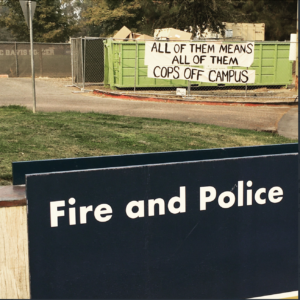
The following essay was written by Abolish the UC in October 2020 in response to the Cops Off Campus statewide day of action.
No Cops, No Campus
When we say “Cops Off Campus,” we recognize policing as far more insidious than the literal daily presence of armed police on UC campuses, lurking in classrooms and student living quarters. Policing is a ubiquitous campus administrative practice that pervades our working, learning, and living environment via ICE agents, Student “Hospitality Officers,” Student Judicial Affairs, various unions and their reps, Campus “Freedom of Expression” Teams, Campus Diversity Directors, and even department chairs and deans tasked with reporting students (or having students report on peers) who are undocumented, threatening to strike, supporting striking colleagues, or just painting graffiti on campus buildings…
The UC not only employs campus police forces; it runs programs that feed new recruits into the state and county forces that habitually brutalize and kill Black, brown, and poor people throughout the so-called US. UCI, for example, feeds so many students into the famously corrupt LAPD that the force uses its high percentage of UC graduates as advertisement. UCPDs accept surplus military weapons designed for armed conflict and use them primarily against student protesters — we all remember when UCPD used military-grade pepper spray at close-range on their students protesting tuition hikes — and as recent reports document, just last year, the UCSC secretly made use of the DHS and federal surveillance technology to surveil campus activists, faculty, workers, and staff. The UC’s use of campus cops opens invariably into relationships with state, federal, and international policing and redoubles a climate of racism, targeted violence, and perpetual stress/danger for the most marginalized members of our communities. “Cops Off Campus” means no more University pigs, but it means an end to their auxiliaries, too: an end to policing in all its forms.
This summer, George Floyd’s murder and the uprisings that followed marked a moment when protests over racist police executions turned decisively from calls for justice and charging killer cops into focused demands for the total abolition of police. While city councils and state legislators dialogued and reshuffled their police budgets in an attempt to placate voters, protests have intensified with the realization that federal and state police are not forces that lawmakers will, or are able to, control. Here at the UC, the university has no mandate to employ police forces, and their presence on public campuses is nowhere decreed or required. We don’t need to agree to or accept the normalization of UCPD’s presence on UC campuses and their ever-increasing budgetary allowance. Police presence is an expression of the UC’s investment in white supremacy and racial capitalism. They serve no other role. Policing is the logic of anti-Blackness and the logic of settler colonialism. Policing is the logic of whiteness and property. We cannot study, think, or stop fearing for our safety in a space where the police are welcome. They shouldn’t be welcome; they’re not welcome. They threaten and traumatize the students, teachers, and workers who are everywhere already disproportionately targeted by state violence: Black, brown, Indigenous, trans, and disabled people.
To ask, “what will the UC do with the money currently earmarked for policing if campus police are dissolved?” is concern trolling. Phrased differently, it’s akin to asking “what alternatives exist, or can be created, to continue policing under a different guise?” There are no “alternatives” to policing in this sense. Policing is an incommensurable violence. Yet this question does demonstrate an unsettling truth: the anti-Black, settler colonial, racial capitalist University cannot exist without policing. A real end to campus policing has to include not just an end to the presence of uniformed officers at the UC, but an end to the compulsion to police our communities — an end to the practices and conditions and World that make policing possible. The University itself is one such condition of that World. To truly get cops off campus requires a real commitment to grappling with and letting go of impulses to control and threaten each other: a real commitment to abolition. That includes the abolition of the University as we know it. We’ll figure out a world without police, without policing. Let’s get cops off campus, sure — but also, let’s have no campus and get cops off the whole fuckin planet.






